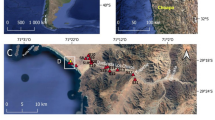Abstract
We present a record of Holocene environmental change on the east coast of Korea, inferred using pollen, carbon-isotopic composition (δ13C), total organic carbon, total sulfur, carbon/nitrogen ratios, particle size analysis and major element geochemistry in a sediment core from Soonpogae Lagoon. A multi-proxy paleoenvironmental approach had not previously been applied in Korea and allowed us to reconstruct climate and vegetation change, sea-level rise, lagoon development, and human impact on the east coast of Korea over the last 8,000 years. Evidence from Soonpogae Lagoon supports the following three conclusions: (1) As a drying trend prevailed on the east coast of Korea after ~5,900 cal yr BP, chemical weathering weakened and herbaceous plants became more important than during the previous humid phase (Holocene Climate Optimum), (2) Sea-level rise on the east coast slowed dramatically about 6,800 cal yr BP, resulting in low rates of sedimentation in Soonpogae Lagoon, and (3) Soonpogae Lagoon was almost completely isolated from the sea by sand barriers when human impact intensified ~2,100 BP.





Similar content being viewed by others
References
Berner RA, Raiswell R (1984) C/S method for distinguishing freshwater from marine sedimentary rocks. Geology 12:365–368
Chang NK (1986) Pollens. Illustrated Flora & Fauna of Korea. vol. 29. Ministry of Education, Republic of Korea (in Korean)
Chang NK, Rim YD (1979) Morphological studies on the pollen of flowering plants in Korea. Seoul National University Press, Seoul
Choi KR (1998) Review: the post—glacial vegetation history of the lowland in Korean peninsula. Korean J Ecol 21:169–174
Choi KR, Kim KH, Kim JW, Kim JC, Lee GK, Yang DY, Nahm WH (2005) Vegetation history since the mid-late glacial from Yeongsan river basin, southwestern Korea. Korean J Ecol 28:37–43 (in Korean with English abstract)
Deines P (1980) The isotopic composition of reduced organic carbon. In: Fritz P, Fontes JC (eds) Handbook of environmental isotope geochemistry, the terrestrial environment, vol 1. Elsevier, Amsterdam, pp 329–406
Domestic Climate Data. Korea Meteorological Administration. n.d. Web. 25 Apr. 2011. http://www.kma.go.kr/weather/climate/average_30years.jsp
Faegri K, Iverson J (1989) Textbook of pollen analysis. Wiley, Chichester
Fujiki T, Yasuda Y (2004) Vegetation history during the Holocene from Lake Hyangho, northeastern Korea. Quat Int 123–125:63–69
Jang BO, Yang DY, Kim JY, Choi KR (2006) Postglacial vegetation history of the central Western Region of the Korean Peninsula. Korean J Ecol 29:573–580 (in Korean with English abstract)
Jo WR (1979) Palynological studies on postglacial age in eastern coastal region, Korea peninsula. Ann Tohoku Geog Assoc 31:23–34 (in Japanese with English abstract)
Jo WR (1980) Holocene sea level change on the east coast of Korea. Geog Rev Jpn 53:317–328 (in Japanese)
Kim M, Park J (2011) Prehistoric rice cultivation and agricultural intensification in the Yeongdong Regions, Gwangwon, South Korea. J Korean Archaeol Soc 79:67–88 (in Korean with English abstract)
Lamb AL, Wilson GP, Leng MJ (2006) A review of coastal palaeoclimate and relative sea level reconstructions using delta C-13 and C/N ratios in organic material. Earth Sci Rev 75:29–57
Lucchini F, Dinelli E, Calanchi N (2003) Chemostratigraphy of Lago Albano sediments (Central Italy): geochemical evidence of palaeoenvironmental changes in late Quaternary. J Paleolimnol 29:109–122
Mason B, Moore CB (1982) Principles of geochemistry. Wiley, New York
Maynard JB (1992) Chemistry of modern soils as a guide to interpreting Precambrian paleosols. J Geol 100:279–289
Meyers PA (1994) Preservation of elemental and isotopic source identification of sedimentary organic matter. Chem Geol 114:289–302
Park J, Kim M (2011) Mid-Holocene paleoenvironmental change at the Yeonsan-dong, Gwangju, South Korea. J Korean Geog Soc 46:414–425
Peterson BJ, Fry B, Hullar M, Saupe S, Wright R (1994) The distribution and stable carbon isotope composition of dissolved organic carbon in estuaries. Estuaries 17:111–121
Prahl FG, Bennett JT, Carpenter R (1980) The early diagenesis of aliphatic hydrocarbons and organic matter in sedimentary particulates from Dabob Bay, Washington. Geochim Cosmochim Acta 44:1967–1976
Reimer P, Baillie MG, Bard E, Bayliss A, Beck J, Bertrand C et al (2004) IntCal04 terrestrial radiocarbon age calibration, 0–26 cal kyr BP. Radiocarbon 46:1029–1058
Selvaraj K, Chen CTA, Lou JY (2007) Holocene East Asian monsoon variability: links to solar and tropical Pacific forcing. Geophys Res Lett 34:L01703
Sheldon ND, Retallack GJ, Tanaka S (2002) Geochemical climofunctions from North America soils and application to paleosols across the Eocene-Oligocene boundary in Oregon. J Geol 110:687–696
Yasuda Y, Kim CM, Lee ST, Yim YJ (1979) Environmental changes and agricultural origin in Korea. In: Overseas research report, Japanese ministry of education, pp. 1–19 (in Japanese)
Yim YJ (1977) Distribution of forest vegetation and climate in the Korean peninsula: IV. Zonal distribution of forest vegetation in relation to thermal climate. Jpn J Ecol 27:269–278
Yoon SO, Moon YR, Hwang S (2008) Pollen analysis from the Holocene sediments of Lake Gyeongpo, Korea and its environmental implications. J Geol Soc Korea 44:781–794 (in Korean with English Abstract)
Yu JE, Lee JH, Kwon KW (2003) An analysis of forest community and dynamics according to elevation in Mt. Sokri and Odae, Korean. J Agric For Meteorol 5:238–246 (in Korean with English abstract)
Yum JG, Takemura K, Tokuoka T, Yu KM (2003) Holocene environmental changes of the Hwajinpo Lagoon on the eastern coast of Korea. J Paleolimnol 29:155–166
Acknowledgments
This research was supported by the Basic Science Research Program through the National Research Foundation of Korea (NRF) funded by the Ministry of Education, Science and Technology (2010-0015554). The authors thank Editor in Chief, Dr. Mark Brenner, and two anonymous reviewers for their useful comments and suggestions in improving the manuscript.
Author information
Authors and Affiliations
Corresponding author
Rights and permissions
About this article
Cite this article
Park, J., Yu, K.B., Lim, H.S. et al. Holocene environmental changes on the east coast of Korea. J Paleolimnol 48, 535–544 (2012). https://doi.org/10.1007/s10933-012-9629-y
Received:
Accepted:
Published:
Issue Date:
DOI: https://doi.org/10.1007/s10933-012-9629-y




